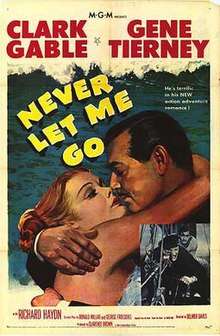Never Let Me Go (1953 film)
Never Let Me Go is a 1953 MGM romantic adventure film[2][3] starring Clark Gable and Gene Tierney. The picture, directed by Delmer Daves and produced by Clarence Brown, was from a screenplay by George Froeschel and Ronald Millar, based on the novel Came the Dawn by Roger Bax (a.k.a. Andrew Garve/Paul Winterton/Paul Somers).
| Never Let Me Go | |
|---|---|
 Theatrical release poster | |
| Directed by | Delmer Daves |
| Produced by | Clarence Brown |
| Screenplay by | George Froeschel Ronald Millar |
| Based on | Came the Dawn 1949 novel by Roger Bax |
| Starring | Clark Gable Gene Tierney |
| Music by | Hans May |
| Cinematography | Robert Krasker |
| Edited by | Frank Clarke |
| Distributed by | Metro-Goldwyn-Mayer |
Release date |
|
Running time | 94 minutes |
| Country | United Kingdom United States |
| Language | English |
| Budget | $1,588,000[1] |
| Box office | $2,418,000[1] |
The supporting cast includes Bernard Miles, Richard Haydn, Belita, Kenneth More, and Theodore Bikel. The movie was shot at MGM's British studios and on location in Cornwall.
Plot
Moscow based newspaper reporter Philip Sutherland (Clark Gable) is in love with Marya (Gene Tierney), a ballerina. He and radio broadcaster Steve Quillan (Kenneth More) go to see her perform Swan Lake with the Bolshoi Ballet, and a pleased Philip learns that Marya wishes to marry him and accompany him home to San Francisco.
They are married in the U.S. embassy, where they are warned that obtaining an exit visa is often quite difficult. On their honeymoon, they meet Christopher Denny (Richard Haydn), an Englishman married to Marya's good friend Svetlana (Anna Valentina), who is pregnant. But when he is seen taking innocent photographs, Denny is taken into custody and banished from Russia.
Svetlana gives birth to a son in Philip and Marya's apartment. Cold War tensions are heightened, and when the Sutherlands attempt to leave, Marya is detained. Philip flies home alone and is unable to get permission to return.
He travels to London, where he and Joe Brooks (Bernard Miles), an experienced boatman, hatch a scheme to sail to a Baltic coast town Tallinn where the Bolshoi is scheduled to perform, in order to clandestinely leave with Marya. At first, he asked Christopher to sail with him so that they could also spirit away Svetlana. But, Christopher declines, as he does not want to subject his young son to the rigors of the sea. Before sailing off, Christopher shows up at the dock ready to join the journey, explaining that his son died after becoming ill with a fever just a few weeks prior. Quillan offers to help by giving them coded instructions on his radio broadcasts as to what time they will meet Marya and Svetlana in the ocean. At their rendezvous point, Svetlana swims out safely to the boat, but says an added ballet performance has forced Marya to stay behind.
Philip swims ashore. Stealing a medical officer's clothes, he attends the ballet. During the bows at the end of the ballet, Marya pretends to faint after seeing Philip in the audience. After examining her in a backstage room, Philip departs with her (apparently to the hospital). But, dancer Valentina Alexandrovna (Belita) recognizes him as her husband and informs the authorities. The pursued car of the Sutherlands goes off a pier. But, first, they leap to safety, and swim together to the dinghy. They embrace as Joe rows them to the boat.
Cast
- Clark Gable as Philip Sutherland
- Gene Tierney as Marya Lamarkina
- Bernard Miles as Joe Brooks
- Richard Haydn as Christopher Wellington St. John Denny
- Belita as Valentina Alexandrovna
- Kenneth More as Steve Quillan
- Karel Stepanek as Commissar
- Theodore Bikel as Lieutenant
- Anna Valentina as Svetlana Mikhailovna
- Frederick Valk as Kuragin
- Peter Illing as N.K.V.D. Man
- Robert Henderson as U.S. Ambassador
- Stanley Maxted as John Barnes
- Meinhart Maur as Lemkov
- Alexis Chesnakov as General Zhdanov
- Anton Diffring as Hotel Desk Clerk (uncredited)
Reception
According to MGM records the film earned $1,482,000 in the US and Canada and $936,000 elsewhere, resulting in a loss of $86,000.[1]
Notes
- The Eddie Mannix Ledger, Los Angeles: Margaret Herrick Library, Center for Motion Picture Study.
- Variety film review; 25 March 1953, page 6.
- Harrison's Reports film review; 28 March 1953, page 51.
External links
| Wikimedia Commons has media related to Never Let Me Go (1953 film). |